The wooden book of Montségur
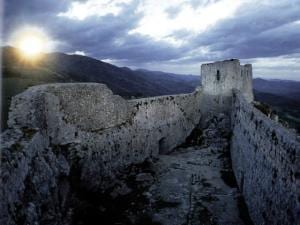
In the early 20th century, a series of palm leaves, containing anomalous writing, were apparently discovered within a hidden cache of the walls of the Cathar castle of Montségur. Though without any intrinsic value, the “wooden book” – as it became known – would become the centrepiece of the esoteric and metaphysical community; its discoverers even labelled it “the Oracle” and said it was able to contact the hidden masters of Agharta.
Montségur is seen as the final stronghold of the Cathar faith, a bastion of true devotion besieged by the worldly ambitions of the papal troops. In March 1244, the Cathars that had been locked inside the castle for months finally surrendered; approximately 220 were burned en masse in a bonfire at the foot of the pog when they refused to renounce their convictions.
In the days prior to the fall of the fortress, four Cathars descended down the steep slopes, allegedly carrying with them a “treasure”. As the descent was steep and arduous, whatever they carried must have been small. Amidst the wild speculation as to what they might have secured – which of course includes the Holy Grail – some believe it was a holy book, containing the wisdom of the Cathar religion. It is indeed unlikely that the Cathars would have secured a physical treasure, if only because it would have been too heavy, and in their eyes, unimportant – Catharism saw everything on this plane of existence as evil and despicable; money and wealth were chief amongst Earth’s – and Satan’s – vices.
Authors such as Walter Birks and R.A. Gilbert, as well as Elizabeth van Buren, have therefore suggested that the Cathars guarded a manuscript, knowledge – a spiritual treasure. This manuscript is often said to be the “Book of Love” and is attributed to St John the Divine, and is claimed to contain “sublime teachings, marvellous revelations, the most secret words confided by our Lord Jesus Christ to the beloved disciple [John the Evangelist]. Their power would be such that all hatred, all anger, all jealousy would vanish from the hearts of men. The Divine Love, like a new flood, would submerge all souls and never again would blood be shed on this earth.”
Though the present ruin at Montségur is not from the Cathar era – the original castle was completely pulled down by the papal troops – the castle is nevertheless seen as the last Cathar stronghold. The current ruin so dramatically occupying the site is referred to by French archaeologists as “Montségur III”, and was slowly rebuilt after the destruction of “Montségur II” in 1244.
With the Cathar stronghold razed to the ground, the fact is that nothing in the present castle can reveal anything about the Cathar past. But despite this obvious problem, some documents have been found in Montségur that are, to say the least, curious and which people have linked with Catharism and the era of their demise. Take for example a text that was discovered in a small cave, near the castle. The document was written in Chinese characters, but it seems this is about all we know about this anomalous discovery. Some, of course, have speculated widely on the subject.
The most remarkable document, however, is the so-called “wooden book”, in truth not made out of wood, nor a book. It is a set of six – and in origin 18 – thin palm leaves, upon which is what is clearly a non-European or Arabic type of writing, as well as some depictions of animals and geometric shapes.
The discovery – version one
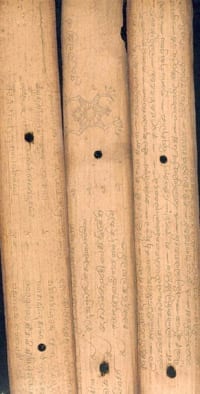 For years, the “feuilles de bois” – the wooden pages – were in the possession of Déodat Roché, one of the most instrumental early researchers of Catharism and even nicknamed “The Cathar Pope” in some quarters. It is unclear whether he had all 18 pages and divided them into three parts, or whether he only got six pages himself. What we do know, is that before his death, he passed six leaves on to his trusted friend and secretary Lucienne Julien.
For years, the “feuilles de bois” – the wooden pages – were in the possession of Déodat Roché, one of the most instrumental early researchers of Catharism and even nicknamed “The Cathar Pope” in some quarters. It is unclear whether he had all 18 pages and divided them into three parts, or whether he only got six pages himself. What we do know, is that before his death, he passed six leaves on to his trusted friend and secretary Lucienne Julien.
She was told that the 18 pages were found when part of the wall of the castle had to be reinforced around 1935 and that a workman found them in a small cavity between some foundation stones. When he informed the site manager, he was told these were of no interest whatsoever, and the labourer thus decided to take them home with him. Julien, a woman known for her honesty, said that she was told that he split the 18 pages between him and his two colleagues, thus each retaining six sheets. The man who had discovered them remained intrigued by his discovery and asked around, showed them to various individuals and eventually, they were given to the Cathar researcher Déodat Roché.
Since the publication of some of these pages in a number of French magazines (e.g. Les Carnets Secrets) and websites, various theories began to circulate on what these pages contained. Some claimed they were of Tibetan origin, linked with the very future of Mankind, “a treasure owned by all of Man”, and calling for World Peace. Perhaps they were used at one time in the Miss Montségur elections?
Others argued that they did not dispute the ownership of Déodat Roché, but that he had not received them from a labourer at Montségur, but instead from none other than Béranger Saunière, the “billionaire priest” of Rennes-le-Château. Did these people suspect that these pages were the infamous parchments that Saunière allegedly found inside a baluster in his church?
In truth, what the pages are, is no major enigma: they are part of a system of astrology known as Nadi astrology (or naadi jothidam). It is a form of astrology mostly practised in the Tamil Nadu, India, and the only enigma is therefore how these pages ended up in Montségur, and why.
The centre of Nadi astrology is a place called Vaitheeswarankoil, near Chidambaram in Tamil Nadu, a state in South India. The divination is based on the belief that the past, present and future lives of all humans were written down by the Seven Sages of the Hindu tradition in ancient times, recorded on these small palm leaves, called Nadis, which were stored in the central library, in the Saraswati Mahal library of Tanjore city, where Nadi astrologers have consulted them since. They are preserved by applying oil extracted from peacock’s blood, though it is said that the Seven Sages originally wrote the Nadis on animal skins.
The texts are availably mainly in Tamil and Sanskrit and are held by certain families who read the results from the palm leaves mostly by taking the thumb impression and some from the palm, as well as birth data. The Nadis link a series of incarnations together, from one’s ‘Poorva Janma’ (previous birth), they promise to help you in the present life. Nadi law argues that when consulting the Nadi library, people will be involuntarily attracted to the leaves of their destiny only. The very word Nadi in Tamil means “(destined) to come on own accord”.
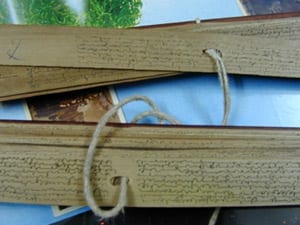 The Nadis have had a turbulent history of their own. The original set of leaves were apparently found lying idle in Vaitheeswarankoil in the 13th century, when there was a renewed interest in them, with exact sets of replicas of the leaves made. During the British Rule, the British were keen to acquire those leaves dealing with herbal cure, alchemy, fortune-telling etc., but left some of the astrological leaves to their loyalists. Some were put to auction and afraid the knowledge would disappear, members of the Valluvar community, which specialized in astrology, bought them back.
The Nadis have had a turbulent history of their own. The original set of leaves were apparently found lying idle in Vaitheeswarankoil in the 13th century, when there was a renewed interest in them, with exact sets of replicas of the leaves made. During the British Rule, the British were keen to acquire those leaves dealing with herbal cure, alchemy, fortune-telling etc., but left some of the astrological leaves to their loyalists. Some were put to auction and afraid the knowledge would disappear, members of the Valluvar community, which specialized in astrology, bought them back.
In March 1995, German author Thomas Ritter was able to have some of the leaves that are in India carbon-dated, which revealed their age to be ca. 350-400 years, or dating from ca. 1600 AD. We asked some Nadi astrologers to give their opinion about the wooden book of Montségur and stated that they were, in their quick assessment, not original Nadi leaves.
Independent analysis has revealed that the writing is Oriya, a language that itself was created from the Kalinga writing in ca. 1050 AD. The cursive style is the result of the texts being written on palm leaves with a pointed stylus, which have a tendency to tear if too many straight lines are made on the surface.
Thus it would appear that though anomalous, the wooden book has no genuine value. It appears that someone was able to lay his hands on – most likely – copies of Nadi palm leaves, brought them to Montségur and hid them there, perhaps out of sympathy with the Cathar cause, or for a more personal reason. Who knows… indeed, who cares. The end?
Version two
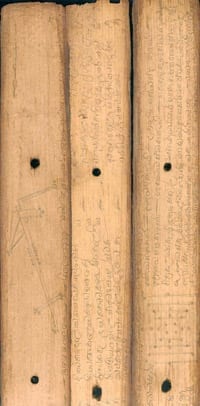 Reality, as always, is slightly more complex. Pages from the wooden book were depicted in a 1967 booklet “Un Oracle kabbalistique”. The authors were Mario Fille and René Odin, and their inclusion in this story makes it all the more intriguing, as both authors were the leaders of an enigmatic society, known as the Polaires, now most famous because of the group’s link with Otto Rahn, the German author who wrote about the Grail and Montségur and who is said to have inspired Nazi supremo Heinrich Himmler in his esoteric ambitions.
Reality, as always, is slightly more complex. Pages from the wooden book were depicted in a 1967 booklet “Un Oracle kabbalistique”. The authors were Mario Fille and René Odin, and their inclusion in this story makes it all the more intriguing, as both authors were the leaders of an enigmatic society, known as the Polaires, now most famous because of the group’s link with Otto Rahn, the German author who wrote about the Grail and Montségur and who is said to have inspired Nazi supremo Heinrich Himmler in his esoteric ambitions.
The Polaires were a group of French esoteric seekers who shared a common interest in a magical system through which they could contact Agartha and the “Masters of the World” that had apparently taken up residence there, after these “leaders of the Soy Cross” had fled the western world in the 17th century. Without going into the specific methodology, it can be said that it shared some things in common, and some things not, with Nadi astrology.
Interestingly, the 37-page thin booklet was recommended by the organisation as a manual to learn the method of divination – known as “the Oracle”, hence the title of the book – that had been described in “Asia Mysteriosa”, a book written by Cesare Accomani, also known as Zam Bhotiva, one of the founders of the Polaires. Most importantly to us, it identifies “the Oracle” as the wooden book itself!
Antonin Gadal was instrumental in the 20th century revival of Catharism and Montségur; he himself continued the work that had been started by the local historian Adolphe Garrigou. From the 1930s onwards, circles were formed around Gadal and the already mentioned Roché; together with René Nelli, they formed “La Société du souvenir de Montségur et du Graal”, to promote the forgotten history of Catharism.
A second circle of Cathar enthusiasts had the countess Pujol-Murat as a key figure; she was one of Rahn’s patrons, being introduced to the young German by the famous French writer Maurice Magré, who had retired to the area. The countess herself claimed to be a descendent of Esclarmonde de Foix, who was seen (though historically inaccurately) as one of the most esteemed Cathar perfects of the early 13th century and in some accounts held to be responsible for the rise of Montségur as the “Vatican” of Catharism.
The Countess followed in the fabled footsteps of her ancestor and together with Accomani started excavations at Montségur. There, they hoped to discover the lost treasure of the Cathars – and the Templars – the Grail, which supposedly was hidden there by Esclarmonde just before she threw herself off the mountain to escape from the papal troops.
In Fille and Odin’s booklet, one chapter is titled “Origine du Manuscrit d’après les confidences du vieux philosophe”, or “Origins of the Manuscript according to the confidences of the old philosopher”, which provides version two of how the wooden book was discovered.
The two authors relate how the old philosopher – actually Fille himself – after forty years of studying the mysteries, had struck up a friendship with the “brilliant engineer” – Odin. They then formed the Polaires, which at the time convened in Paris and maintained links with several other esoteric societies.
“We had regular contacts with foreign countries and it was during a reunion in Great-Britain, which we attended, that three mediums, two French and Miss Silver Star, well-known there, told us, with the approval of the widow of Sir Arthur Conan Doyle, president of an English group, that one of the ten treasures of the Knights Templar remained hidden in Montségur or in Lordat.” It is known that the trip to London occurred in January 1931 and “Miss Silver Star” was Grace Cooke, indeed a well-known medium. She was invited to join the group, accepted the offer, journeying to France in the company of her husband and Lady Conan Doyle, for whom she would later famously channel her dead husband. As a medium, Cooke had a spirit guide “White Eagle”, and following the channelings of Arthur Conan Doyle, Cooke founded the White Eagle Lodge in February 1936, which some have seen as the English equivalent – if not successor – of the Polaires.
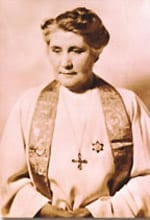 Image: Grace Cook
Image: Grace Cook
In 1931, when Fille and Accomani returned to Paris, they asked for permission to hold a series of excavations, in Montségur and Lordat, another important Cathar stronghold in the region, that attained fame during the Cathar Resurgence in the early 14th century, organised by one of the last known Cathar perfects, Pierre Authie. The group received authorisation for the excavation, apparently due to pressure applied by their friend Maurice Magré, who functioned as their consultant.
During the excavations, which lasted ca. forty days in 1931, both in Montségur and Lordat, a group of fervent English spiritualists joined them on a type of pilgrimage. “Dressed in white and holding lit candles”, they sang in honour of Esclarmonde de Foix. Today, such spectacles are largely lacking from archaeological digs – and they are obviously all the less colourful for it. However, it seems that the chanting occurred largely because in 1930, Accomani had written a book “La Magie appliqué à l’art du chant” – Magic applied to the art of singing.
Amazingly, the prophecy came true; something was apparently found. One day, while Fille and Odin were surveying the excavations, Fille noticed that one part of a wall of the castle of Montségur was in a slightly different colour than the rest of the building. When they struck it with a hammer, they found a niche, into which were stored the yellowed papers, separated by a stone.
The top layers of these papers had been corroded by moisture. Only one word could be read: Fatalité – Fate. The lower sections were better preserved and were found to be parchments on which there were numbers and geometric figures. Odin was quick to conclude that this was a “divinatory oracle”. After six months of passionate study, he was able to reconstitute the Cabbala, as it was believed that these parchments were linked with the Jewish mystical teachings. Fille added that they also consulted all of the libraries of Paris and the surrounding areas and that all enquiries returned with the statement that not a single document resembled or came close to these parchments. It was felt to be unique. Today, we know that this is not the case, but noting we merely arrived at correctly identifying their origin due to the powerful search engines of the Internet, we should not be too harsh on Odin and Fille. Even if it had not been unique, they had their Oracle – and their conclusion that it was a divinatory system was largely correct. Indeed, even the link with the Seven Masters, or the Initiates of Agharta, is a qualified interpretation – though Fille and Odin would refer to Nine Masters, not seven.
The third alternative
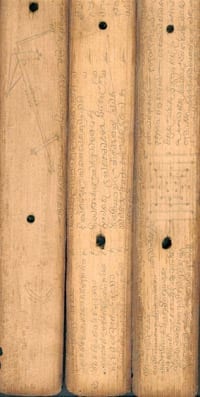 In both versions, the wooden pages are discovered in a wall of the castle of Montségur, in the 1930s. In one account, it are labourers that divide the discovery; in the other, a group of esoteric archaeologists. The two accounts match quite neatly, and Julien’s version, which she must have received from Roché, might merely have stripped the story from its esoteric layer.
In both versions, the wooden pages are discovered in a wall of the castle of Montségur, in the 1930s. In one account, it are labourers that divide the discovery; in the other, a group of esoteric archaeologists. The two accounts match quite neatly, and Julien’s version, which she must have received from Roché, might merely have stripped the story from its esoteric layer.
However, there is a third version, which was painstakingly reconstructed by Dutch researcher Milko Bogaard, who was however unaware that the wooden book had survived. Bogaard was aware of the “Un Oracle kabbalistique” booklet, and noted that this document was at odds with earlier allegations made by Fille, as well as the known history of the Polaires. This should perhaps be unsurprising, seeing the booklet was published in 1967 and the Polaires existed from ca. 1929 to 1939.
To quote Bogaard: “according to the available but limited sources, the history of this Order starts in Italy back in 1908 where a young Mario Fille meets a mysterious hermit during a holiday in Bagnaia [near Rome]. […] Fille apparently received some old and withered parchments from the old hermit who stated: ‘What you have here are some pages taken from the Book of Science of Life and Death: these pages contain a successful Method of Divination on an arithmetical basis.’” The hermit, “Father Julian” (Padre Guiliano) then explained the system, apparently telling Fille only to consult the oracle in times of need. This occurred in 1920, when Fille used the divinatory technique, and spoke about it to Cesaro Accomani, during a voyage to Egypt. The rest, as they say, is history.
Fille and Accomani would go on to found the Polaires and would indeed excavate at Montségur. But somewhere between 1939 and the late 1960s, Fille and Odin changed the story of how the parchments had been discovered, claiming they had found the parchments in Montségur. Why? Because the historical documents reveal that during their excavation at Montségur and Lordat, in truth, nothing at all was discovered. As such, Cooke’s prophecy and their psychic questing was an utter failure. No wonder therefore that three decades later, they preferred to rewrite history.
Hence, “the wooden book of Montségur” should really be called “the wooden book of Father Julian”. Bogaard also notes that in the 1930s, Odin was on record as stating that “the oracle is not Kabbalistic. It is a form of telepathic telegraphy where the numbers represent a transmission of communications sent by sapient beings who exist on the Material Plane. The method is strictly mathematical.” Hence, despite three alternative versions of how it was found, in all three, it remained a method of divination.
That Fille indeed changed the story in the 1960s is in evidence as when Fille and Accomani settled in Paris in the 1920s, they demonstrated the oracle to a group of writers and journalists, including Magré and even the illustrious René Guénon, who initially helped Fille and Accomani in uncovering the powers of the Oracle, but after two years, left the group, disappointed not so much in the human aspect, but in the power of the Oracle itself. But – for us more importantly - as these shows occurred before their excavation in Montségur was organised, it is clear that version two, published in 1967, was a deliberate falsification.
Who was Father Julian? He was largely portrayed as a Tibetan initiate, someone who had returned to Europe from their exile in Agartha. Who was he really? Bogaard highlights that in the first issue of the Polaires’ official bulletin, there is discussion about Father Julian’s imminent death. “Coincidentally”, it corresponded with the death of a great Italian occultist, Giuliano Kremmerz; Julian = Giuliano. Kremmerz (real name: Ciro Formisano) was the founder of the Fratellanza Terapeutica e Magica di Myriam, the Therapeutic and Magic Brotherhood of Myriam. How he acquired it, we can only speculate on – a divinatory method we will soon indulge in too.
The Oracle
The wooden book is an interesting example of how an ordinary set of Nadi leaves became the centre of an entire spiritual movement, who promoted these pages to the “Oracle of the Astral Force”, which was said to be a unique method of communication between the user and the “Rosicrucian Initiatic Centre of Mysterious Asia”, better known as Agartha, and its so-called nine hidden masters. As mentioned, Fille argued that Father Julian was one of the highest initiates on Earth, directing the Fate – that word allegedly written on some of the pages of the wooden book – of Mankind from their secret monastery “somewhere” in Tibet.
Historical records indicate that it was the wooden book that prophesized that Fille and Accomani had to found the Polaires, which they did in 1929. What their specific ambition was by formalising the group that used the Oracle, is unknown, but we can only guess – and fear – when we learn more detail of the organisation’s make-up and its ancestry.
Though Fille is often seen as the leader of the group, there was a position of “Grand Master of the Secret Order”, which had to be “someone of high rank or position”. He was apparently (going to be) dispatched from the Himalayas, but never arrived. Hence, the group were expecting one of the Nine to arrive from Agartha, to once again take up residency in Western Europe, and lead Europe to its rightful “Fate”.
With Father Julian dead – though proclaimed to have returned to Agartha – a new leader was required. It seems that this role was briefly taken up by the heir of the Royal House of Cambodia, Prince You-Kantor. It appears that when he left, René Odin filled this void; as we are by then close to the Second World War, when the Order would be persecuted by the Germans, Odin seems to have been the last “Grand Master”.
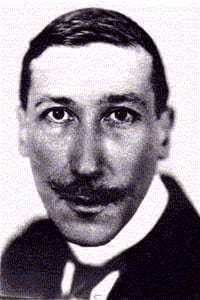 Image: René Guenon
Image: René Guenon
He and Fille would later claim that the Oracle actually prophesized the advent of a Second World War, as well as the destruction of the Brotherhood and there is indeed evidence to suggest both did state as much before the events happened. Of course, both predictions came true, though, it has to be said, no true prophetic powers were required to arrive at these conclusions in the 1930s.
Indeed, as mentioned, not everyone was impressed with the Oracle. Bogaard relates how Guénon “was captivated by the oracle but his interest slowly faded. The messages of the initiates of the Himalaya became more and more uninteresting and even pathetic to Guénon. […] He tested the oracle by posing several doctrinal questions. The responses he received were rather vague and evasive, and therefore unsatisfactory.” Accomni too, after the excavations in Montségur, left the Polaires in 1932, apparently thoroughly disgusted with the organisation – if not the Oracle itself – which he had promoted, but which failed to find the “lost treasure” of Montségur. Perhaps it is another reason why Fille and Odin in the 1960s decided to rewrite history, making the Oracle into the “lost treasure” they had allegedly discovered inside a wall of the castle.
Fallout
Bogaard notes that the group that surrounded the Oracle in the early 1930s was influenced by the ideology of Saint-Yves d’Alveydre. In his 1910 book “Mission de l’Inde en Europe”, d’Alveydre described his knowledge of the underground world of Agartha, claiming he had received this information when a group of Eastern initiates has visited him in 1885. He claimed they influenced the Fate – that word again – of the world, guided it, through a form of government that d’Alveydre labelled synarchy. Synarchy, seen as the opposite of anarchy, has been variously defined. D’Alveydre defined it as a form of government, in which the Masters telepathically communicated their desires to a secret society, which in turn ruled government, whether French, European… or global.
The Oracle – the means of communication – being “strictly mathematical”, the Polaires organised themselves around the numbers three and – especially – nine (3x3). Their Inner Group was lead by The Nine and it is not the first time I chanced upon “them”. Working with Clive Prince and Lynn Picknett in “The Stargate Conspiracy”, I mapped the history of The Nine post Second World War, whereby the authors made repeated references to d’Alveydre and his influence on modern politics – or at least political ambitions. Specifically, séances organised by Andrija Puharich involving nine people channelling “the Nine Principles” (linked with the Egyptian Creator deity Atum and his Nine Principles) led to the interest of the CIA in using such psychic communications. This would eventually result in a series of Remote Viewing projects, that were run by the CIA and DIA (Defence Intelligence Agency) from the 1970s to 1995.
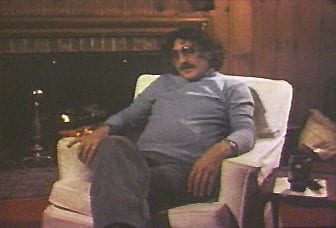 Image: Andrija Puharich
Image: Andrija Puharich
Interestingly, Puharich’s séances required the presence of a powerful medium, which in the 1970s was none other than Uri Geller, who was apparently the only person Puharich had ever encountered that was able to channel “The Nine” directly. No doubt a sign of the times, by the 1970s, Puharich had labelled “The Nine” extra-terrestrial beings, rather than residents of a Himalayan realm.
In his analysis of the rituals of the Polaires, Bogaard too has identified their need for a powerful medium, which was used in the communication with The Nine. It was this role that was apparently the main driver for Fille and Accomani to visit Cooke in London, who would thus not only channel Sir Arthur Conan Doyle, but also “The Nine”. Bogaard, however, notes that little more can be said about this period, through lack of historical documents on the Polaires. But noting that this was the period when Otto Rahn hung around the Polaires, knowing what we know about Himmler’s interest in Tibet and the occult, we can only divine what he had in mind for Nazi Germany… and why, today, French occult circles are seen by some as synonymous with extreme right-wing politics.
Finally, when Puharich began his “Nine séances” in the United States, a French esotericist, Jacques Breyer, began to communicate with The Nine from within a tower of the castle of Arginy, near Lyon. He argued that “his” Nine were the souls of the nine founding knights of the Knights Templar. Is it a coincidence that amongst the alchemical drawings that Breyer made on the walls of the tower are designs that match designs found in the wooden book?
The Sacred Mountain and the Sacred Path
The Polaires believed that there was a “Sacred Mountain”, once in the Polar regions, but then apparently moved to Tibet, the residence of The Nine, Agartha. It seems that the Polaires saw the pog of Montségur as the local “Sacred Mountain”, which somehow acted as a “substation” for contacting The Nine in Agartha. Author Nigel Graddon notes that Otto Rahn “perceived the Pog as a Sacred Centre, an antenna of initiatory energy that transmitted its mystic rays to all those embarked upon a personal path.” It seems Rahn got those views from the Polaires, who indeed considered it to be their mission to master the so-called “red rays”, which would soon be confronted with the “blue rays”, in a powerful battle between the two forces – World War Two.
The conical hill of Montségur, where the Cathars burnt like the mythical Phoenix of Heliopolis – another centre associated with The Nine, this mountain was definitely reworked into the Sacred Mountain of the Polaires.
 What about the origins of the wooden book of Giuliano Kremmerz? He practiced alchemy at the same time, in the same city (Naples) as Arturo Reghini, who worked with Julius Evola, later to be a confidant of Mussolini. Interestingly, Reghini was known for his translations of Swami Vivekananda, the first known Hindu Sage to come to the West. Did he bring with him a set of Nadi leaves?
What about the origins of the wooden book of Giuliano Kremmerz? He practiced alchemy at the same time, in the same city (Naples) as Arturo Reghini, who worked with Julius Evola, later to be a confidant of Mussolini. Interestingly, Reghini was known for his translations of Swami Vivekananda, the first known Hindu Sage to come to the West. Did he bring with him a set of Nadi leaves?
Furthermore, knowing that d’Alveydre borrowed from Louis Jacolliot, who was not only a judge in Pondichery and French consul of Calcutta, India, but especially the first person to write about Agartha, we may have uncovered the true origins of the wooden book: the exposure of European esotericists to Nadi astrology, either in India itself, or through travelling Swamis. Indeed, even the number of pages of the Oracle – 18 (2x9) – matches the number of palm leaves that are ordinarily consulted in a Nadi astrological session.
From here, a set of Nadi palm leaves grew into Oracle and a means to communicate with “The Nine Hidden Masters”, people – entities – who were deemed to have evolved into something more than human, enlightened, and considered to be the true – rightful – leaders of the Fate of the world, who should influence the “governments of the world” as to where our true destiny should lie. Here lies the seed as to why today the Dalai Lama is considered to be, by some if not many, more than “just” the exiled leader of the state of Tibet.
In the early 20th century, both Reghini and Giuliano Kremmerz stressed that theirs was a quest for knowledge and warned against the confusion between spiritual achievement and bouts of emotional excitement. Early in his career Reghini had written: "The symbolism of architecture, ceremonies, and images is superior to ordinary language due to the multitude of meanings which only symbolism can express, since it works through analogy; the hieroglyphic and ideogram forms of writing are superior to ordinary writing due to the breadth and precision of their meaning."
In the wooden book of Montségur, they had precisely such a mechanism. But, as usual, the gimmick would begin to take centre stage, while true spiritual achievement was pushed further back. It is why Guénon would leave the Polaires. It is perhaps why Fille and/or Odin decided to give the palm leaves to Roché, who himself told Julien it was probably best she never spoke of them herself.
Alas, as recently as 2007, the wooden book became the subject of a criminal complaint lodged at Couiza – at the foot of the village of Rennes-le-Château – whereby the complaint detailed that one of the current owners of part of the wooden book was not entitled to possess it. The plaintiff claimed that unlike the legal owner, he was “properly” spiritually equipped to be the book’s “rightful” owner. 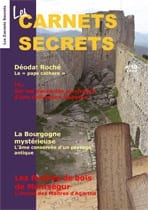 Esclarmonde de Foix, if not The Nine Masters themselves, would likely have thrown themselves off their respective Sacred Mountains if they had heard to what squabbling ownership of “the Oracle” had been reduced to. Then again, it was a century of mythmaking that had made an ordinary replica set of Nadi palm leaves into something it never was: the Oracle, the only instrument through which the Western world could learn its Fate from the Hidden Masters of Agartha.
Esclarmonde de Foix, if not The Nine Masters themselves, would likely have thrown themselves off their respective Sacred Mountains if they had heard to what squabbling ownership of “the Oracle” had been reduced to. Then again, it was a century of mythmaking that had made an ordinary replica set of Nadi palm leaves into something it never was: the Oracle, the only instrument through which the Western world could learn its Fate from the Hidden Masters of Agartha.
Philip Coppens<
This article appeared in Les Carnets Secrets 10 (2008).
- Inicie sesión o regístrese para enviar comentarios
Similar By Terms
|
(English)
|
(English)
|
(Deutsch)
|
(Español)
|
|
(English)
|
(English)
|
(English)
|
(Русский)
|







Comentarios recientes
hace 13 años 44 semanas
hace 13 años 44 semanas
hace 13 años 45 semanas
hace 13 años 45 semanas
hace 13 años 48 semanas
hace 14 años 2 semanas